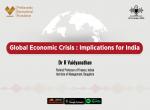Paul Theroux in his book, ‘Riding The Iron Rooster’ has made some fascinating comments on China which can help us in trying to understand why China is today an economic power-house and India is still struggling. This book was written in 1988 and describes a series of train journeys that Theroux undertook across China in trains which were obviously not the new Bullet Trains that China has now introduced.
Starting from Victoria Station in London Theroux travels across Europe, Russia, and Mongolia and then enters China through Inner Mongolia, making landfall at Datong. After the emptiness of Mongolia Theroux finds Datong and the China it represents to be shabby, busy, disorderly, very crowded and thoroughly polluted by smog which was a combination of desert dust, fog and industrial smoke. The shops were full of goods; there was an air of prosperity, but coal as the source of energy and manufacture, especially of steam locomotives, created a lasting impression. The industrial process was not automated, but everyone was busy working. The guiding philosophy was the three great goals of the workers. To quote Theroux these goals were, “timing of production, so that no work was wasted; keeping the right mental attitude; and increasing productivity”.
I have begun this paper by referring at some length to the very first impression that Paul Theroux had when he entered China from Mongolia. It was one of a country which has industries, whose people had a mindset of production and whose government obviously had a commitment to manufacturing. After the revolution Mao Tse Tung deliberately fostered an economic policy which strove to build a huge manufacturing sector in the country so that China could become an industrialised nation. Remember the slogan that China would overtake America in steel production? The huge number of backyard furnaces that came up and produced very low quality pig iron was a part of this effort to industrialise. Not much pig iron was produced this way, but the people were weaned away from a rural psyche to one in which manufacturing became central to the economy. It must be remembered that in China only ten percent of the total land area is cultivable and more than sixty percent of the land consists of uncultivable wasteland. Geology, geography, topography, hydrology and soil morphology encouraged, in fact mandated, that China could not continue to prosper on the basis of agriculture alone. The industrial revolution in China was then an inevitable consequence of the land configuration, though to give Mao credit he hastened the transition from a basically subsistence rural economy to a very powerful industrial economy.
Industrialisation carries with it a number of prerequisites, sequential growth of support infrastructure, capital requirement and capital formation and research and development which would lead to invention, innovation and improvement. Industry cannot survive without power and the development of the power sector becomes a sine quo non for industrialisation. The development of communications so that goods, people and services can be transported over long distances is absolutely essential for industrial growth. Because a country starting from a low level of economic capability does need assistance for capital formation and for development of technology, China had to find partners. Therefore, despite the fact that China is a Communist country whose ideal is socialism and State ownership of the means of production, China opted for an open door policy in which foreign investment was welcomed and the off-shoring of foreign industry and its location in China was encouraged. China provided the land space and labour and many of the world industries established a base in China. A great deal of Chinese industrial grown has taken place because of this open door policy. The Chinese Government at no stage felt that it could not keep the multinational corporations under control and, therefore, the Chinese had no hesitation in letting in foreign capital. Despite the handicap of having a one-party rule and a judicial system which is certainly not Anglo Saxon, China has been able to reassure the foreign investor that his investment would be safe.
Let us contrast this with India. We have always been suspicious of foreigners coming and investing in India because after all the East India Company and its Dutch, French, Portuguese and Danish counterparts initially came to India for trade. Because of a succession of wars in Europe in which Britain emerged as the dominant naval power and also a great military power on land, the French, Portuguese and other European interventions in India were virtually liquidated and Britain emerged as the supreme European power. Starting from trading posts such as Bombay, Surat and Calcutta the British trader gradually grew into being an arbiter in matters of local, native administration and the East India Company expanded into an imperial power. These memories are fresh in the Indian mind and, therefore, the Indian people and the Indian politicians have always had a deep- rooted suspicion and antipathy towards the successors to the East India Company, the multinational corporations. That is why there is strong political opposition to allowing foreigners to come and take over our companies, our manufacturing units and our trade outlets. Surprisingly China, which calls itself a Peoples Republic and has the single party rule of the Communist Party of China, is today most openly capitalist and gives the warmest possible welcome to foreign investors. India, on the other hand, is a multi-party democracy in which the word “socialist” used in the Preamble to the Constitution is more a comforting slogan than a political commitment, but we are still hostile to the idea of foreigners participating in our economy because we still feel that Surat may become the base of a foreign empire. That does explain why there is such strong political revulsion whenever the question of opening up of our market to foreigners comes up for discussion.
Trade created an empire in India and, subsequently, this empire systematically destroyed such manufacturing capabilities that India had so that the factory-made goods of Britain may be sold in the Indian market and India may then be reduced to the position of a supplier of primary products to Britain. Despite this history the Government of India has decided to open up two sectors of the Indian economy to Foreign Direct Investment. These are retail trade and the civil aviation sector, the latter named being in absolute shambles because of mismanagement. Foreign Direct Investment in the retail sector is strongly opposed by the Left, BJP, Trinamool Congress and several such parties, some of which are a part of the present Congress led coalition. The argument advanced by government is that foreigners taking over the aviation industry will pump necessary working capital into the system and this part of the economy would revive. Similarly, Foreign Direct Investment in retail trade would cut out middlemen, create the infrastructure which would enable the supply chain to reach from the farmer right up to the customer in the retail store and would bring direct benefit to the cultivators while ensuing good quality of the produce and a reasonable price for the urban consumers. It is argued that the present system of agricultural production and marketing is such that there is considerable wastage of agricultural produce by inappropriate storage, spoilage and even destruction through putrefaction in the process of transporting the produce from field to market. The foreign investment retail chains would reach out directly to the producer, create adequate storage, including cold storage facilities and build an efficient transport system which would quickly bring goods to the retail stores. This would put more money in the hands of farmers, prevent wastage and enable the consumer to buy agricultural products at an affordable price. The fact that it would throw a very large number of small vendors, road side hawker and itinerant sellers who carry fruits and vegetables on hand carts right up to the doorstep out of a job does not seem to bother our American Business School, World Bank trained or oriented economists and policy makers.
We seem to be quite willing to allow foreign investors to invest capital, including working capital, in airline companies, most of which are utterly mismanaged. Why do we not encourage foreign investors like British Aerospace, Boeing, Dassault, etc., to invest in producing aircraft in India? Why do we not try and have foreign companies invest in building factories for producing the refrigeration equipment which keeps cold storage plants functional? In other words, why do we not encourage foreign companies to invest in the secondary sector in a big way in India? We have had a fair amount of success in the Build, Operate and Transfer model (BOT model) of road construction and certainly on highways such as that which connects Bhopal to Indore the BOT model has enabled a first rate road to be built. If a sufficiency of off-shoring of manufacturing facilities is done in India we would certainly be able to create more gainful employment, India would be able to evolve an industrial culture instead of the present satisfaction with trading and as our manufacturing capacity increases, we would become a major industrial power, economic power and military power. Obviously we need to take a fresh look at our policy relating to Foreign Direct Investment in India. Given the choice I would cut down all FDI in retail trade, the service sector such as running an airline and in real estate. I would have an open door policy towards investment in the secondary sector, including the setting up of hundred percent foreign owned manufacturing facilities in India. I would certainly give meaningful incentives for investment in physical infrastructure. My only restriction would be that employment generated by these activities would go to the citizens of this country so that their earning and welfare are enhanced.
The great advantage of having a powerful industrial economy is that it forces the manufacturing companies to invest in more research and development because if they do not improve, innovate and invent, their products will become unsaleable in the market. Therefore, industrial growth will bring about simultaneous growth in scientific research for the purpose of innovation and invention. This, in turn, will strengthen our institutions of technology and management because as industry grows, as the need for research grows, the market for these disciplines will expand, the research and development establishment will become stronger and the Institutes of Technology and Management will be forced to redesign teaching methodologies to keep up with the new demand.
My final words would be that government must realise that so far as the foreign direct investor is concerned, he would prefer an activity in which his own capital investment is miniscule, there is a quick turnover of commodities and, therefore, profits are earned almost simultaneously with trading. The gestation period in envisaging, constructing, commissioning of an industrial establishment and then going into commercial production is quite long and profit would have to be deferred to an appropriate date in the future. That is why in India trade is more attractive than manufacture. This would be true of the foreign direct investor also. We need to break this mindset, to make the industrialist realise that waiting for profit is not such a bad idea after all because the production capacity created will yield results year after year after year and that a well managed industrial enterprise will always be more profitable than just trade, whilst being less risky because it is unlikely to be affected by daily market fluctuations which retail trade has to face. Therefore, let economic reforms be targeted at opening up our economy to productive investment but not indiscriminately to trade. America and the developed world want exactly the opposite to happen and this we must resist.
Published Date: 2nd October 2012








Post new comment